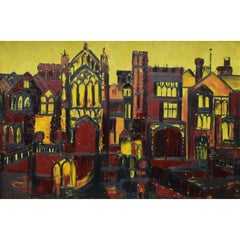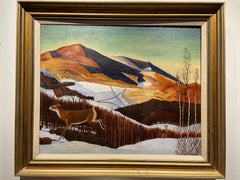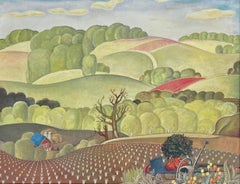J. Phillip Davies Landscape Paintings
to
1
Overall Width
to
Overall Height
to
1
1
1
1
1
1
1
658
599
321
250
1
Artist: J. Phillip Davies
J Phillip Davies: Selwyn College Cambridge - oil painting: Modern British Art
By J. Phillip Davies
Located in London, GB
J Phillip Davies (British, 20th Century)
Selwyn College Cambridge
oil on board
c. 1970
60x89cm
Category
1970s Modern J. Phillip Davies Landscape Paintings
Materials
Oil
Related Items
Vintage Rockwell Kent Copy of "Vermont Winter 1921" Oil on Canvas Painting, 1960
By Rockwell Kent
Located in Baltimore, MD
This large painting is a ca. 1960 copy of a famous Rockwell Kent painting that was executed in Vermont in 1921. The work is oil on canvas and well represents the original image, tho...
Category
1960s American Modern J. Phillip Davies Landscape Paintings
Materials
Oil
$895
H 25 in W 30 in D 3 in
WPA Landscape American Scene Social Realism Mid 20th Century Modern Farm Rural
By James McCracken
Located in New York, NY
WPA Landscape American Scene Social Realism Mid 20th Century Modern Farm Rural
James McCracken (1875 – 1967)
WPA Landscape
28 x 36 inches
Oil on canvas, c. 1930s
Signed lower right
...
Category
1930s American Modern J. Phillip Davies Landscape Paintings
Materials
Canvas, Oil
Buffalo, NY Steel Mill American Scene Modernism WPA Era Industrial 20th Century
Located in New York, NY
Buffalo, NY Steel Mill American Scene Modernism WPA Era Industrial 20th Century
Ruth A. Haven Gay (1911-1992)
“Buffalo, NY Steel Mill”, c. 1935
23 x 28 inches
Oil on canvas
Signed G...
Category
1930s American Modern J. Phillip Davies Landscape Paintings
Materials
Oil, Canvas
Painting 'Vela' P. Fragiacomo, circa 1910s
By Pietro Fragiacomo
Located in Vicenza, VI
Oil painting on panel by artist P. Fragiacomo, dating from the 1910s.
The work, titled "Sail," depicts a small sailboat in the middle of the sea with a figure on board seen from behi...
Category
Early 1900s Modern J. Phillip Davies Landscape Paintings
Materials
Canvas, Oil
$1,174
H 9.06 in W 12.21 in D 0.4 in
"6th Avenue El" American Scene Social Realism Mid-20th Century New York City
By Ernest Fiene
Located in New York, NY
"6th Avenue El" American Scene Social Realism Mid-20th Century New York City
Ernest Fiene (1894-1965)
"6th Avenue El"
12 1/4 x 14 1/4
Oil on canvas board, c. 1940s
Signed lower righ...
Category
1940s American Modern J. Phillip Davies Landscape Paintings
Materials
Oil, Board
Fishing Below a Covered Bridge, Vermont
By Eric Sloane
Located in New York, NY
Inscribed lower left: [WEST]FORD BRIDGE / [CA]MBRIDGE VT; signed lower right: SLOANE
Category
20th Century American Modern J. Phillip Davies Landscape Paintings
Materials
Oil
Summer Resort in Michigan -Modernist Mid-Century Saugatuck Oil Painting
Located in Marco Island, FL
Summer Resort in Michigan is an exceptional work painted by the Chicago Modernist, William Schwartz. He studied at the Art Institute of Chicago shortly ...
Category
1940s American Modern J. Phillip Davies Landscape Paintings
Materials
Canvas, Oil
$68,000
H 51 in W 33 in D 2 in
The Happy Farmer oil painting by Gregorio Prestopino
By Gregorio Prestopino
Located in Hudson, NY
Provenance: The Artist. Menikoff collection (friends of the artist)
About this artist: Born in Little Italy in 1907, Gregorio Prestopino first set out to become a sign painter as the son of New York City immigrants. Instead, his talent provided a life-changing scholarship to the National Academy of Design, and for five years he studied drawing under C. W. Hawthorne. He spent the summer of 1934 at the MacDowell Colony in Peterborough, New Hampshire. His deep involvement with the colony led him to later serve as its director in 1954.
Much of Prestopino’s work was in the vein of social realism. During the 1940s and 1950s he became deeply invested in portraying everyday Manhattan and Harlem scenes. He first became interested in the Ashcan school at the National Academy of Design, and remained committed to an interest in working with urban scenes. His lively treatment of people and events revealed his affinity for sixteenth-century artist Pieter Breughel. Later in his career, he focused on producing images of nudes and picturesque New Hampshire landscapes, and investigated the relationship between color and form.
Prestopino exhibited at several biennials at the Corcoran Gallery, at the Art Institute of Chicago, the Museum of Modern Art. His work was frequently shown at the Pennsylvania Academy of Fine Arts, where he was awarded the Temple Gold Medal in 1946 and an additional prize in 1952. He was awarded a National Institute of Arts and Letter Grant in 1961, and in 1972 the National Academy of Design awarded him the Altman Figure Painting Award.
Prestopino’s artistic cache skyrocketed when Life magazine published his images from New York’s maximum security institution Green Haven as part of its “Prison Series” in 1957. That same year his paintings and sketches of urban life were featured in the short film Harlem Wednesday. Directed by John and Faith Hubley...
Category
1930s Modern J. Phillip Davies Landscape Paintings
Materials
Canvas, Oil
$6,500
H 26 in W 38 in
Autumn Day Drive oil painting by Arnold Friedman
By Arnold Friedman
Located in Hudson, NY
Painting size 12 ½" x 14 ½", framed 18" x 20 ¼" x 2"
Signed "Friedman" lower right
Inscribed verso: "Title: Autumn Day Drive. Associated impressions of two drives Hudson River and F...
Category
1930s Modern J. Phillip Davies Landscape Paintings
Materials
Oil, Panel
Autumn Color
Located in North Clarendon, VT
Striking regionalist painting by American/Hungarian artist Charles Harsanyi. Autumn Colors in Stephenstown NY. 15" x 20" Oil on board with bold brushwork housed in a 19.25 x 24.25 white washed period frame.
Charles Harsanyi (American, 1905-1973)
Charles E. Harsanyi was born in Tapolcza, Hungary in 1905. He studied at the Royal Academy in Budapest, Hungary with A. Bankhard from 1923 to 1928. Nineteen years later, in 1947, Harsanyi moved to the U. S., settling in Jackson Heights, New York.
The painter and drawing specialist became a member of numerous prestigious art clubs including the Salmagundi Club, The Society of Independent Artists and the Allied Artists of America. Harsanyi served as an awards director and chairman of admissions for the Audubon Artists Association during the 1950s.
Later in life after living in Stephentown, New York and Cape Coral, Florida, Harsanyi passed away in Fort Myers, Florida in 1973.
STUDIED
Royal Academy in Budapest, Hungary with A. Bankhard, 1923-28
MEMBER
Salmagundi Club, 1941
Brooklyn Painters & Sculptors
American Artists Congress
Society of Independent Artists
Audubon Artists Association, jury awards director, 1952; chairman admissions
committee, 1953; nominating committee, 1955, 1956
Artists Fellow
Allied Artists of America, life member; jury awards 1945; jury selection, 1954
AWARDS
Long Island Art League, 1954 (prize)
Cumberland Valley Artists, 1949, 1950, 1952 (prizes)
EXHIBITIONS:
Society of Independent Artists, 1929, 1930, 1936-40, 1943, 1944
National Academy of Design, 1933-55
Salons of America, 1934
Brooklyn Museum, 1934
Corcoran Gallery, 1935-51 (four times)
Allied Artists of America, 1935-53 (bronze medals 1944, 1953)
Doctor Saharunis Art Gallery, Naples, Florida, 1970s
American Federation of Arts traveling exhibit
Farnsworth Museum, 1950
Springfield Museum of Art, 1947-50
Denver Art Museum, 1937-39
Washington County Museum of Fine Art, 1937-46 (prizes 1938, 39, 41, 43, 54)
(gold medal 1946)
Butter Art Institute, 1953
World's Fair, New York, 1939
Baltimore Museum of Art, 1939
Art Institute of Chicago, 1941-44
Cincinnati Art Museum, 1941
Pennsylvania Academy of the Fine Arts, 1942, 1948, 1949
Salmagundi Club, 1946 (prize), 1951 (prize)
Connecticut Academy of Fine Arts, 1942, 1943, 1945, 1953, 1955 (William Bradford...
Category
1940s American Modern J. Phillip Davies Landscape Paintings
Materials
Oil
1940 WPA School EXHIBITED Painting SPRING FLOOD by Morris Shulman
By Morris Shulman
Located in Exton, PA
Fine WPA period painting by Morris Shulman. The painting is oil on canvass measuring 24" x 30". Signed M Shulman and dated '40 at the lower right. Titled verso "Spring Flood." Shul...
Category
1930s Modern J. Phillip Davies Landscape Paintings
Materials
Oil
$4,400 Sale Price
20% Off
H 34 in W 40 in D 2 in
Boys Swimming Industrial Landscape WPA Mid 20th Century Social Realism Modernism
By Henry Ernst Schnakenberg
Located in New York, NY
Boys Swimming Industrial Landscape WPA Mid 20th Century Social Realism Modernism
Henry Schnakenberg (1982 - 1970)
Boys Swimming Industrial Landscape
11 1/2 x 15 1/2 sight
Oil on Canvas
Signed lower left
14 1/2 x 18 1/2 inches, Framed
Bio
In many cases, American artists visited the Armory Show in New York in 1913, and returned to their studios to react to or against what they saw. However, for Henry Ernest Schnakenberg it was much more life altering. Prior to visiting this important exhibition of American and European modernist art...
Category
1940s American Modern J. Phillip Davies Landscape Paintings
Materials
Canvas, Oil
J. Phillip Davies landscape paintings for sale on 1stDibs.
Find a wide variety of authentic J. Phillip Davies landscape paintings available for sale on 1stDibs. You can also browse by medium to find art by J. Phillip Davies in oil paint, paint and more. Much of the original work by this artist or collective was created during the 1970s and is mostly associated with the modern style. Not every interior allows for large J. Phillip Davies landscape paintings, so small editions measuring 36 inches across are available. Customers who are interested in this artist might also find the work of Nahum Tschacbasov, David Hayes, and Enid Smiley. J. Phillip Davies landscape paintings prices can differ depending upon medium, time period and other attributes. On 1stDibs, the price for these items starts at $4,135 and tops out at $4,135, while the average work can sell for $4,135.


